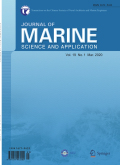- 钛学术文献服务平台 \
- 学术期刊 \
- 工业技术期刊 \
- 大学学报期刊 \
- 船舶与海洋工程学报(英文版)期刊 \
Ship Roll Analysis Using CFD-Derived Roll Damping:Numerical and Experimental Study
Ship Roll Analysis Using CFD-Derived Roll Damping:Numerical and Experimental Study
基本信息来源于合作网站,原文需代理用户跳转至来源网站获取
摘要:
This study investigates the roll decay of a fishing vessel by experiments and computational fluid dynamics (CFD) simulations. A fishing vessel roll decay is tested experimentally for different initial roll angles. The roll decay is also simulated numerically by CFD simulations and is validated against the experimental results. It shows that the roll damping could be obtained by CFD with high level of accuracy. The linear and nonlinear damping terms are extracted from the CFD roll decay results and are used in a potential-based solver. In this way we are using a hybrid solver that benefits the accuracy of the CFD results in terms of roll damping estimation and the fast computations of the potential-based solver at the same time. This hybrid method is used for reproducing the free roll decays at Fn=0 and also in analyzing some cases in waves. The experiments, CFD and the hybrid parts are described in detail. It is shown that the suggested method is capable of doing the simulations in a very short time with high level of accuracy. This strategy could be used for many seakeeping analyses.

推荐文章
Groundwater quality assessment using multivariate analysis, geostatistical modeling, and water quali
Groundwater
Multivariate analysis
Geostatistical modeling
Geochemical modeling
Mineralization
Ordinary Kriging
Spatial analysis of carbon storage density of mid-subtropical forests using geostatistics: a case st
Carbon storage density
Geostatistics
Mid-subtropical forests
Spatial autocorrelation
Spatial heterogeneity
An experimental study of interaction between pure water and alkaline feldspar at high temperatures a
Alkaline feldspar
Autoclave
High-temperature and high-pressure experiments
An experimental study on metal precipitation driven by fluid mixing: implications for genesis of car
Metal precipitation
Fluid mixing
Sulfur species
MVT lead–zinc ore deposits
Carbonate-hosted
lead–zinc deposits
内容分析
关键词云
关键词热度
相关文献总数
(/次)
(/年)
文献信息
| 篇名 | Ship Roll Analysis Using CFD-Derived Roll Damping:Numerical and Experimental Study | ||
| 来源期刊 | 船舶与海洋工程学报(英文版) | 学科 | |
| 关键词 | |||
| 年,卷(期) | 2022,(1) | 所属期刊栏目 | |
| 研究方向 | 页码范围 | 67-79 | |
| 页数 | 13页 | 分类号 | |
| 字数 | 语种 | 英文 | |
| DOI | |||
五维指标
引文网络
引文网络
二级参考文献 (0)
共引文献 (0)
参考文献 (0)
节点文献
引证文献 (0)
同被引文献 (0)
二级引证文献 (0)
2022(0)
- 参考文献(0)
- 二级参考文献(0)
- 引证文献(0)
- 二级引证文献(0)
引文网络交叉学科
相关学者/机构
期刊影响力
船舶与海洋工程学报(英文版)
主办单位:
哈尔滨工程大学
出版周期:
季刊
ISSN:
1671-9433
CN:
23-1505/T
开本:
大16开
出版地:
哈尔滨市南岗区南通大街145-1号楼
邮发代号:
14-323
创刊时间:
2002
语种:
eng
出版文献量(篇)
1019
总下载数(次)
0
总被引数(次)
2815
期刊文献
相关文献
推荐文献
- 期刊分类
- 期刊(年)
- 期刊(期)
- 期刊推荐
一般工业技术
交通运输
军事科技
冶金工业
动力工程
化学工业
原子能技术
大学学报
建筑科学
无线电电子学与电信技术
机械与仪表工业
水利工程
环境科学与安全科学
电工技术
石油与天然气工业
矿业工程
自动化技术与计算机技术
航空航天
轻工业与手工业
金属学与金属工艺
船舶与海洋工程学报(英文版)2022
船舶与海洋工程学报(英文版)2021
船舶与海洋工程学报(英文版)2020
船舶与海洋工程学报(英文版)2019
船舶与海洋工程学报(英文版)2018
船舶与海洋工程学报(英文版)2017
船舶与海洋工程学报(英文版)2016
船舶与海洋工程学报(英文版)2015
船舶与海洋工程学报(英文版)2014
船舶与海洋工程学报(英文版)2013
船舶与海洋工程学报(英文版)2012
船舶与海洋工程学报(英文版)2011
船舶与海洋工程学报(英文版)2010
船舶与海洋工程学报(英文版)2009
船舶与海洋工程学报(英文版)2008
船舶与海洋工程学报(英文版)2007
船舶与海洋工程学报(英文版)2006
船舶与海洋工程学报(英文版)2005
船舶与海洋工程学报(英文版)2004
船舶与海洋工程学报(英文版)2003
船舶与海洋工程学报(英文版)2002

 免费查重
免费查重










